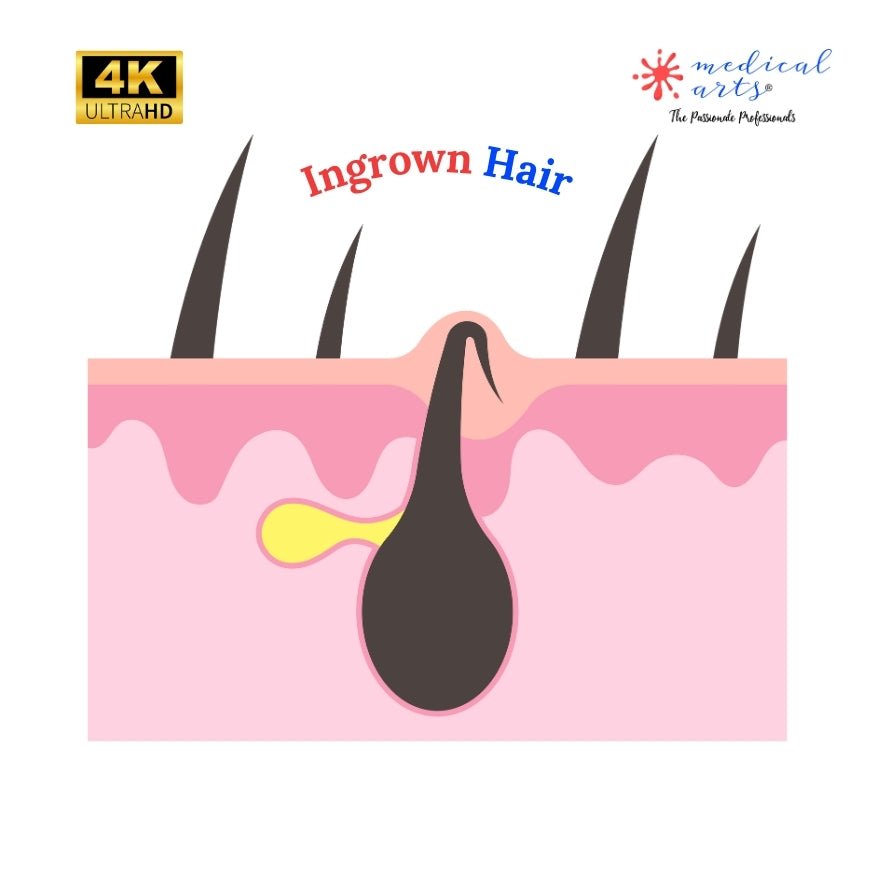Ingrown Hairs & The Role of Laser Hair Removal
Ingrown hair is a common skin condition where hair curls back or grows sideways into the skin. It can occur in any area where hair is removed through shaving, waxing, or plucking. Ingrown hairs are often characterized by small, raised bumps on the skin, which may be red, itchy, and uncomfortable. In some cases, they can become infected and turn into painful, pus-filled sores.

Causes of Ingrown Hair
- Hair Removal Methods: Shaving, waxing, and plucking can lead to ingrown hairs. These methods can cause the hair to break off unevenly with a sharp tip, which can pierce the skin and cause ingrown hair.
- Curly Hair: People with curly or coarse hair are more prone to ingrown hairs, especially in the beard area or the pubic region. Curly hair is more likely to bend back and re-enter the skin after being cut.
- Clogged Pores: Dead skin cells can clog up hair follicles, forcing the hair inside to grow sideways.
Symptoms of ingrown hair
- Red, small, raised bumps (papules)
- Pus-filled blisters (pustules)
- Hyperpigmentation (darkening of the skin)
- Pain and itching
- Embedded hairs visible under the skin
Prevention of ingrown hair
- Exfoliation: Regularly exfoliating the skin can help remove dead skin cells and reduce the risk of ingrown hairs.
- Proper Shaving Techniques: Using a sharp, single-bladed razor, shaving toward hair growth, and moisturizing shaving cream can reduce the risk.
- Avoid Tight Clothing: Tight clothing can exacerbate ingrown hairs, especially after removal.

Treatments for ingrown hair
- Topical Treatments: Over-the-counter and prescription creams and ointments can help reduce inflammation and treat infections.
- Sterile Tweezers or Needles: For visible ingrown hairs, gently teasing the hair with a sterile needle or tweezers can be effective. However, this must be done with caution to avoid infection.
- Warm Compresses: Applying warm compresses can help soften the skin and bring the hair to the surface.
- Laser Hair Removal: A more permanent solution, laser hair removal, can significantly reduce the occurrence of ingrown hairs. It involves using concentrated light to destroy hair follicles, preventing future hair growth.
Laser Hair Removal
Laser hair removal is one of the most effective treatments for preventing ingrown hairs. It's particularly beneficial for people with dark, coarse hair and those with chronic ingrown hairs.
How it Works: The laser emits light absorbed by the pigment (melanin) in the hair. The light energy is converted to heat, which damages the hair follicles, inhibiting or delaying future hair growth.
Sessions Required: Multiple sessions are usually needed, spaced several weeks apart, to catch all hair in its growth phase.
Effectiveness: It is highly effective, with many patients seeing a significant reduction in hair growth after the first few sessions.
Considerations: The procedure is less effective on light-coloured hair and may require more sessions. It is also essential to consult with a dermatologist to ensure suitability for the treatment, especially for individuals with certain
skin conditions or those taking specific medications.
Risks and Side Effects of Laser Hair Removal
- Skin Irritation: Temporary discomfort, redness, and swelling are possible after laser hair removal.
- Pigment Changes: The treated skin may become slightly darker or lighter, particularly in darker-skinned people. These changes are usually temporary.
- Rare Complications: In rare cases, laser hair removal can cause blistering, scarring, or other changes in skin texture.
Aftercare and Recovery
- Avoid Sun Exposure: Protect the treated area from the sun until the skin heals completely.
- Gentle Skincare: Use mild, non-abrasive cleansers and moisturizers on the treated area.
- Avoid Other Hair Removal Methods: Do not pluck or wax the area between laser treatments, as this can interfere with the procedure's effectiveness.

